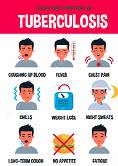Ghana News | Ghana Politics | Breaking News in Ghana

Tuberculosis - clock ticking
In medical circles, each year on March 24, the global community commemorates World Tuberculosis (TB) Day to raise public awareness of the devastating health, social and economic consequences of TB and to step up efforts to end the global TB epidemic.
The date marks the day in 1882 when Dr Robert Koch announced that he had discovered the bacterium that causes TB, which opened the way towards diagnosing and curing this disease.
Advertisement
The global aim this year on the theme ‘The Clock is Ticking’ conveys the sense that the world is running out of time to act on the commitments made by global leaders to end TB.
This is especially critical in the context of the COVID-19 pandemic that has put End TB progress at risk, and to ensure equitable access to prevention and care in line with the World Health Organisation’s (WHO’s) drive towards achieving Universal Health Coverage.
Global
On the global scene, tuberculosis ranks above HIV/AIDS as the most common infectious cause of mortality.
This disease is caused mainly by Mycobacterium tuberculosis and two other related organisms: Mycobacterium africanuum and Mycobacterium bovis.
The natural reservoir of M. tuberculosis is the human host. An untreated GeneXpert-positive pulmonary tuberculosis is the primary source of infection.
The disease predominantly affects the pulmonary system, but sometimes affects other organs in the human body.
The infective dose is only a small amount of droplet nuclei. In the absence of appropriate TB control measures, it was estimated that approximately one billion people will become infected, 150 million of whom will become symptomatic and 36 million will die from the disease between 2002 and 2020.
At the end of 2019, an estimated 10 million people fell ill with TB worldwide, including 5.6 million men, 3.2 million women and 1.2 million children. Though preventable and curable, TB was associated with an estimated 1.2 million deaths among HIV-negative people and an additional 208,000 deaths among HIV-positive people, making TB a leading cause of death from a single infectious agent WHO states that the disease is predominantly found in men compared to women and greatest burden is in the economically active age group.
Transmission
The bacteria that causes TB is transmitted when a healthy person comes into contact with Bacilli containing droplet nuclei via coughing, sneezing, singing or speaking. The duration of exposure has a direct association with transmission of the infection.
The infectious droplet nuclei that are formed within five minutes of talking or in a single cough can remain airborne for 30 minutes.
The inhalation of respiratory droplets containing M. tuberculosis with ensuing deposition in the lungs may lead to one of four possible outcomes: rapid clearance of the organism, primary disease, latent infection or reactivation disease.
About five to 10 per cent of people living with latent infection and with no present history of medical co-morbidities following an index infection develop reactivation disease.
There is a marked increase in the lifetime risk of reactivation among patients afflicted with human immunodeficiency virus (HIV) and other medical conditions.
Prompt diagnosis of active TB enhances treatment success and reduces community transmission. The stepwise approach to diagnosis of TB includes thorough history, physical examination to assess the susceptibility of the patient to TB, GeneXpert, chest radiography, sputum acid-fast bacilli (AFB) smear and culture with at least one specimen sent for DNA testing.
TB usually has a gradual onset and presents with low grade fever, mild to chronic cough (with or without blood) and in severe cases weight loss, loss of appetite, fatigue and night sweats. According to the updated algorithm of TB diagnosis, when a person presents with cough of two to three weeks’ duration or cough less than one week with fever, night sweats and weight loss in the presence of positive risk factors (history of prior TB infection or disease, known or possible TB exposure, and/or past or present residence in or travel to an area where TB is endemic), it should give a clinician a high index suspicion of pulmonary TB.
Treatment
TB can be treated and cured. An estimated 43 million lives escaped the burden of TB through prompt diagnosis and treatment between the year 2000 and 2014.
A standard six-month course of four antimicrobial agents under a Directly Observed Treatment Short-course (DOTS) is the baseline treatment strategy for an active, drug-sensitive TB disease. The goal of DOTS is to reduce TB morbidity and mortality and the chance of Mycobacterium tuberculosis developing resistance to primary treatment drugs.
Treatment compliance can be difficult without direct supervision and support from family and health care volunteers and incomplete treatment may result in deleterious effects including death. The six-month course for TB treatment in newly diagnosed TB cases entails the combination of Isoniazid, Rifampicin, Ethambutol and Pyrazinamide, which are the first line drugs.




